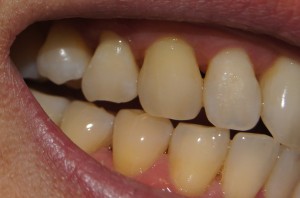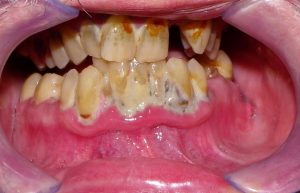Gum disease from a dentist who has it
Posted: July 12, 2012
Last Modified: March 9, 2022
Dr. Wong has gum disease. There, I said it. While it may sound ludicrous that a dentist may have gum disease, a better understanding of the disease will quickly make it plausible. And while dentistry has reached a pretty high level of understanding of the processes, we are still stymied by many of the facets of gum disease.

Another admission: I’ve been dreading having to write this post. Gum disease, or actually periodontal disease, is a complicated subject that covers so many topics that I have little hope of covering the entire material in one measly blog posting.
Let’s start with the definition of gum disease. There is actually no single disease called “gum disease”. Instead, we are talking about a whole host of problems that can affect the periodontal (i.e.: around the tooth) tissues. This would include not just the gums, but the underlying bone and ligament as well.
Gum diseases are categorized in an ever-changing and likely ever-more complicated way. See how it is currently categorized by the International Periodontal community here. As dental knowledge evolves, it will likely change some more.
We spoke earlier about gingivitis, a term that everyone probably knows. We mentioned that gingivitis is generally regarded as a fully reversible condition – when arrested, the gums will not suffer any lasting effects. When we talk about gum disease, we’re referring also to things that can cause permanent damage or loss of tissue. So, for starters, true gum disease, or more accurately, periodontitis, can be thought of as “continued loss of the supporting tissues of teeth”.
Let’s get to the point – gum disease is a loss of the ligament, bone, and soft tissues around teeth. The ultimate consequence, and the most worrisome, is tooth loss. When a tooth loses enough support, it will eventually become so loose that it cannot function properly.

In the past, gum disease was often blamed on poor hygiene. If someone had gum disease, it must have meant that there was just inadequate cleaning of the teeth/gums. However, this did not answer the question of why some people with poor oral hygiene did not experience gum disease, and why some people with good oral hygiene did.
The destruction of ligament and bone around teeth is indeed triggered by bacteria (for the most part), but it is the body’s response to the bacteria that determine the extent of gum disease that develops. As it turns out, it is not only the quantity and quality of bacteria, there are also known risk factors that come into play. We’ll get into that later.
It is easy to believe that malicious oral bacteria are actively destroying gum and bone around teeth, but that would be overly simplistic. When bacterial toxins are detected by the body, an inflammatory reaction begins in an attempt to rid the gums of the offending irritants. Inside the body, this reaction usually works pretty well. On teeth, where the bacteria are stuck to the roots of teeth in a protective biofilm, the body cannot so easily eliminate the bacteria. The inflammation persists, and just like collateral damage, the immune response actually ends up destroying the body’s own bone and ligament.
The severity of gum disease also depends on the risk factors that the patient posseses. The presence of these factors may make the disease worse or better for any given bacterial load. These risk factors include: smoking, diabetes, stress, a family history of gum disease, underlying immunodeficiencies, as well as local factors such as crooked teeth and failing dental work that both act to make effective oral hygiene measures more difficult.
This makes periodontitis frustrating – one can do one’s best in oral hygiene and still have bone loss more severe than those who don’t try as hard.
Here is where periodontitis is also frustrating for the dental team: it seldom hurts, until it is at the very late stages (and sometimes does not hurt even then), and since many people acknowledge dental problems only when pain develops, the motivation to treat the disease is not that great. Yet, we also know that the prognosis of the disease is much better if tackled early.
If not pain, then what are the signs that dentists look for when assessing a mouth for periodontal disease? Just like many other diseases, many indicators put together will combine to give an overall picture of the disease. Our team will look at the colour and tone of the tissues, periodontal pockets, bleeding on probing, recessions, mobilities, furcations, and bone levels as clinical measures in addition to the risk factors listed above.
What can you do about gum disease? If you have it, it is important to address it promptly. This means two things: optimizing your oral hygiene through proper brushing and flossing, as well as reducing those risk factors that can be modified. Quitting smoking, getting diabetes (glucose levels) controlled, and choosing better, less-gum-disease-prone parents would all be helpful.
That’s it for today. You’ll notice that we totally neglected to cover the broad broad categories of treatment and prognosis. We will come to that in a later posting.
If you believe that you may have gum disease or risk factors for gum disease, please contact us for an evaluation! We’d love to be your dentist in Barrie.


